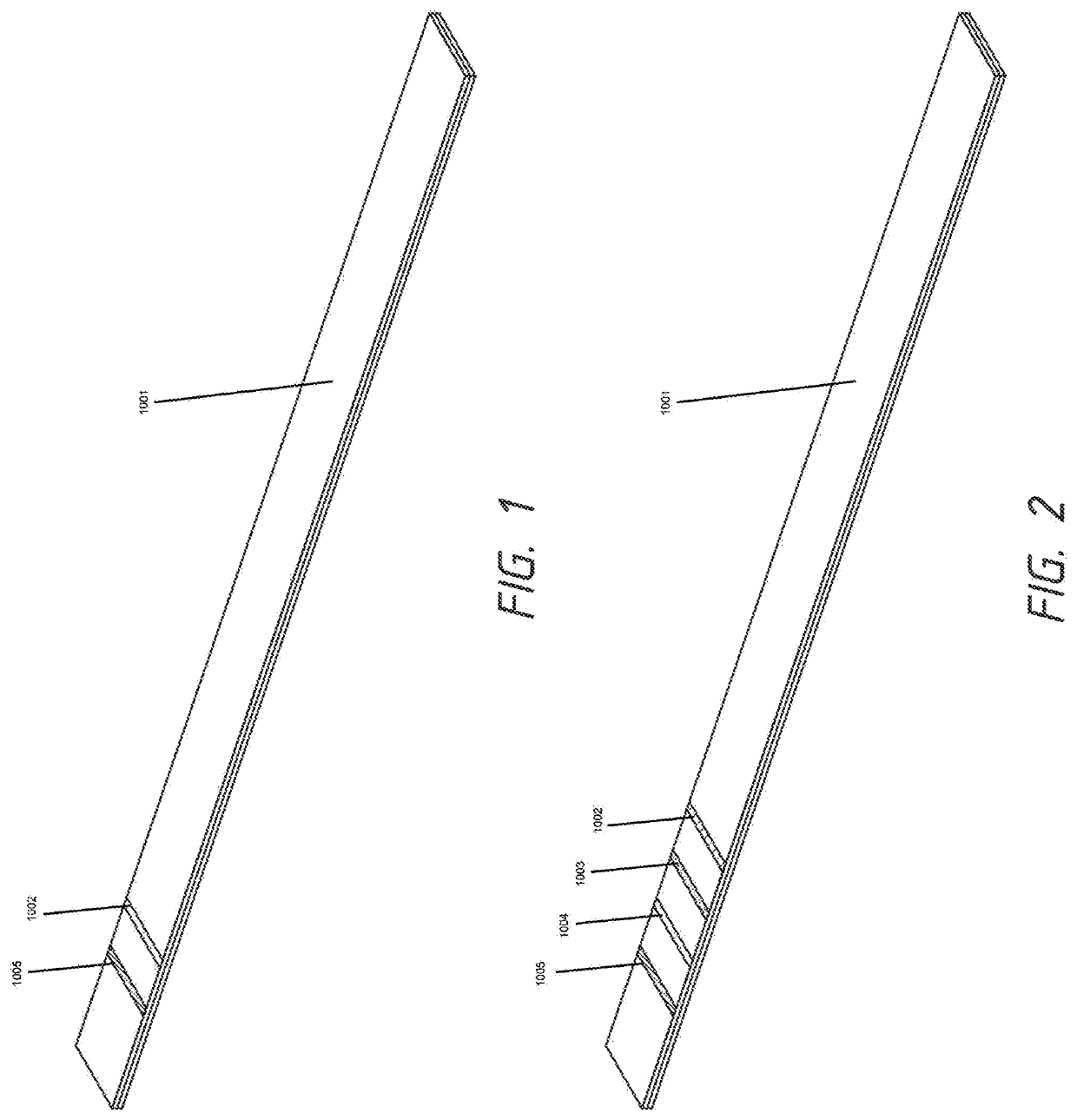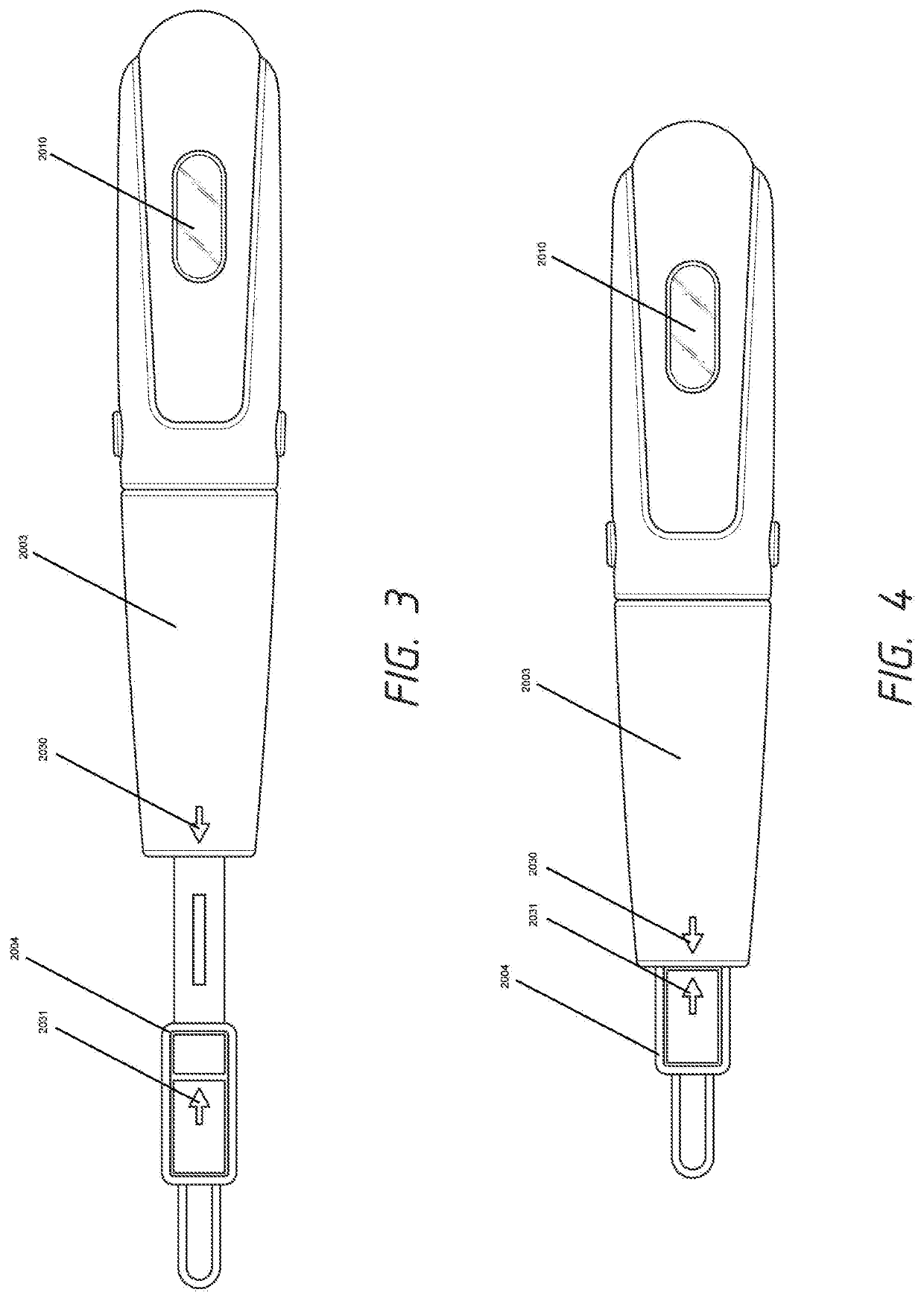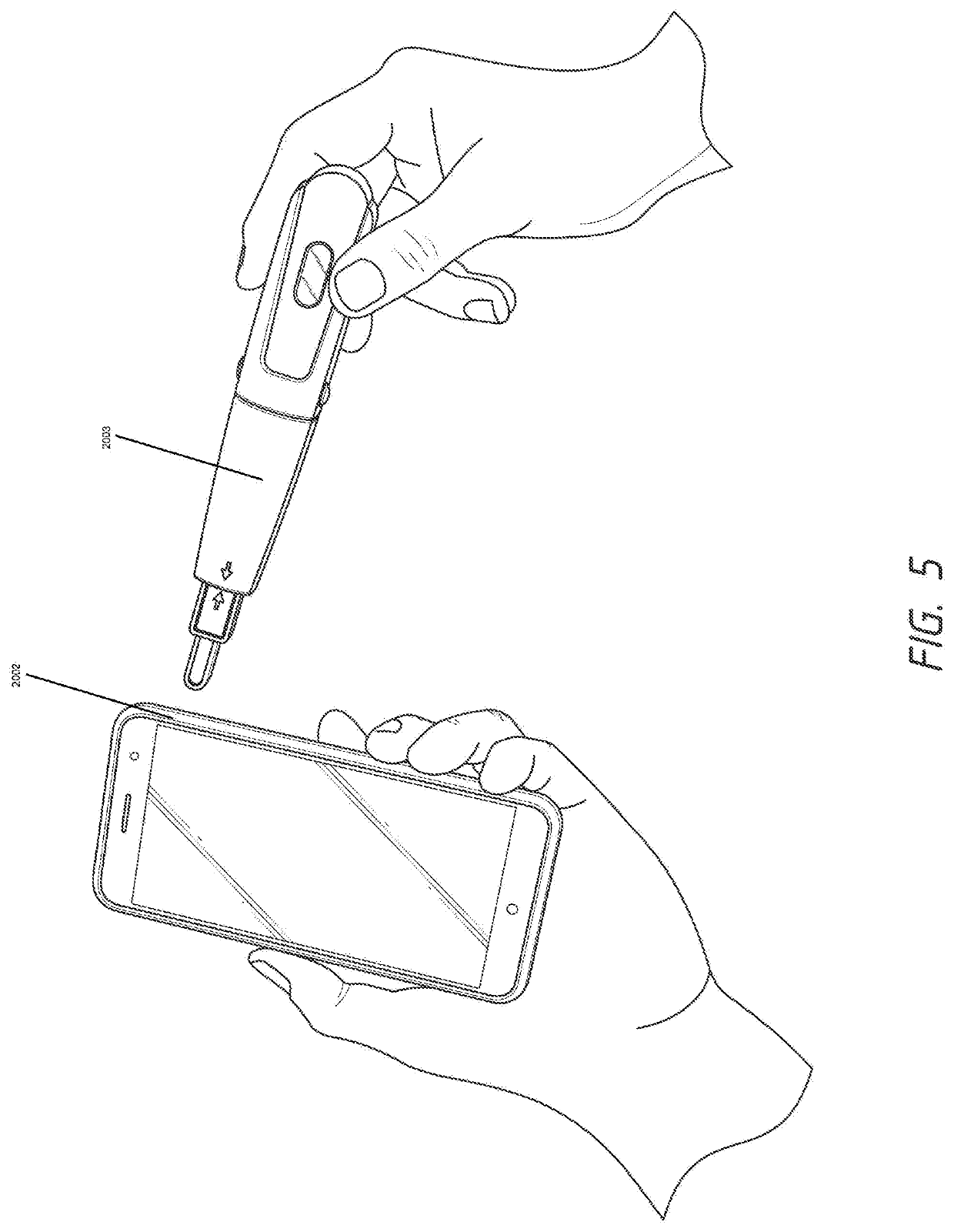Thus, lateral flow
assay-based tests configured to evaluate for the presence of other hormones cannot be easily re-configured to evaluate for the presence of progesterone or its analytes.
Such testing devices, however, do not have the capability to receive or evaluate results from lateral flow
assay-based tests configured to detect for the presence of progesterone or progesterone analytes (such as PdG), which present in a significantly different manner.
Previous attempts to present a
colored line on a lateral flow
assay-based test intended to display a line to indicate a positive result for the presence of PdG, in contrast, have proven unreliable and wildly inaccurate.
However, such methods and smartphone devices, including the teachings described in European
Patent Application EP 3,335,638 A1 filed Dec. 13, 2016, are not configured to or utilized to detect for the absence of color on a test, or
color intensity below a certain threshold on a lateral flow assay-based test, such lacking color indicating a positive result for the presence of PdG.
The challenge, however, associated with reliance upon LH-based ovulatory prediction is the mere predictory nature of detecting the LH surge to only estimate future
ovulation.
Thus, a test configured only to detect the presence of LH as widely known in the prior art does not sufficiently confirm
ovulation.
Previously known tests have not been successfully configured to reproducibly and consistently interpret results for the presence of progesterone or its analytes in urine.
Previous attempts to standardize the configuration of tests and methods for evaluation of urine for progesterone or its analytes heretofore have led to unreliable and difficult-to-interpret results.
Previous attempts to configure a test to detect progesterone and / or its analytes have proven ineffective and unreliable.
A variety of challenges exist with such method, including that body temperature fluctuations could be caused by sources unrelated to ovulation, thereby rendering the results uncertain.
Moreover, the BBT method is widely regarded as
time consuming, difficult to measure, and often inaccurate.
A challenge associated with such techniques is that they can only provide predictive and / or imprecise information, including information merely associated with anticipated future events in the
menstrual cycle.
LH tests do not allow a woman to reliably assess whether she is in an infertile period or otherwise in a risk period for
pregnancy in case of unprotected intercourse.
Resultantly, such non-progesterone tests are of limited and uncertain use, particularly in association with the avoidance of unwanted
pregnancy as further discussed below.
A related problem is that such a process is a
time consuming and costly mechanism for testing the presence of progesterone.
As a result, progesterone tests accomplished via the evaluation of
blood serum are generally impractical for many uses deriving from progesterone testing, including such uses as the avoidance of pregnancy.
Such cumbersome processes also complicate determination of whether low progesterone exists during pregnancy threatening a
miscarriage.
However, the procedures associated with drawing a female's blood to determine progesterone levels in association with the determination of ovulation,
fertility planning, the assessment of the viability of pregnancy, to assess the onset of
menopause and to engage in activities related to pregnancy avoidance render testing for serum progesterone impractical.
Such attempts have proven fruitless due to inaccuracies associated with the tests with regard to the precision of detection and measurement of PdG.
Further, the tests based on the detection of PdG in urine are complex, difficult to implement.
Specifically, it has yet to have been discovered how to create a progesterone test result discernable by the
naked eye, despite years of effort.
Currently, progesterone tests are generally limited to use within a lab environment.
GB 2,204,398 A as published on Nov. 9, 1988, and similar prior art items, were unsuccessful due to the technical difficulties and inappropriate selection of component antibodies (namely the selection of component antibodies of improper isotypes) and the complexity associated with the assay
system.
In certain cases, such technical difficulties also were associated with the development of
antigen and
antibody chemistries of such ratios, component parts and / or elements to specifically produce visual results readable to the
naked eye.
However, the utilization of BSA as a
carrier protein is inadequate for usage in a urine-based progesterone or PdG testing solution intended to display results visible and discernable to the
naked eye.
This is because the utilization of BSA as the
carrier protein results in a testing solution lacking the ability to adequately bind to
colloidal gold (or other visual
label), thereby resulting in a test delivering results that are problematically imperceptible to the naked eye.
The
resultant test incorporating BSA is ineffective and highly unreliable.
The specific
carrier protein and
specific antibody isotype associated with the Van Der Geest and Ulmann disclosure do not result in an effective combination to evaluate urine for the presence of PdG.
These and other prior art attempts have failed to result in a device that reliably and reproducibly produces enough
color intensity to deliver clear and easily interpreted test results to confirm the presence of PdG for users with minimal training and a lack of specialized equipment.
Many previously unaddressed problems are associated with the configurations taught in the Quidel reference.
First, the complexity of the three zone test disclosed in Quidel renders it difficult to reproduce.
Moreover, the difficulty in
reproduction has been observed to have been caused in part by the difficulty in controlling the precise amount of PdG bound into the sink.
Previously obtained inaccurate and inconsistent results associated with the Quidel test may have occurred because of its utilization of a barrier zone or
reagent sink.
In this publication, they described inconsistent and inaccurate results in association with the use of the test described in the Quidel reference during the evaluation of urine for PdG.
Specifically, the paper stated that “the [Quidel] PdG test had limited specificity to PdG because it would occasionally read positive before ovulation would take place.” Due to its inaccuracy and inconsistency, the Quidel test is moreover therefore not a useful tool for tracking ovulation.
Prior art solutions are associated with challenges
stemming from problematic
antibody and PdG carrier
protein (also referred to as the critical reagents or
hormone binding partners) conjugation, selection and incorporation, often due to the conjugation, selection and incorporation of improperly chosen antibodies,
antibody isotypes, conjugation techniques, or carrier proteins.
A problem associated with prior art solutions is that the specifically chosen critical reagents with such solutions are undesirably cross-reactive.
The wrongly chosen antibodies in prior art solutions are outside of a desired detection range.
For instance, the wrongly chosen antibodies may result in a test that is not sensitive enough to allow a user to distinguish a positive and negative result.
A problem with prior art tests having a particular suboptimal combination antibody, antibody
isotype and / or carrier
protein, is that the antibody and the PdG conjugate do not bind with the precision necessary to produce a viable, reproducible test result useful to detect the presence of PdG.
However, the previously known diagnostic tests have not been improved to evaluate urine for progesterone or its analytes.
Further, none of the tests provide information indicating whether if ovulation has occurred, one can engage in unprotected
sexual intercourse without risking unwanted pregnancy, whether progesterone levels are sufficient to support a pregnancy, or whether
menopause has occurred.
Previously known implementations of progesterone and PdG
urine testing strips have been of insufficient quality to effectively work in conjunction with the electronic sensors and displays described above.
Understandably, because the severe consequence of imperfect advice concerning
fertility status may be an unwanted pregnancy, the tendency has been to exercise extreme caution and to require testing of the relevant parameter or parameters throughout the cycle, and particularly right from the onset of the cycle (onset of menses).
Therefore, there remains and unmet need for disposable testing devices configured to evaluate urine for the presence of PdG and display the results.
 Login to View More
Login to View More  Login to View More
Login to View More 


